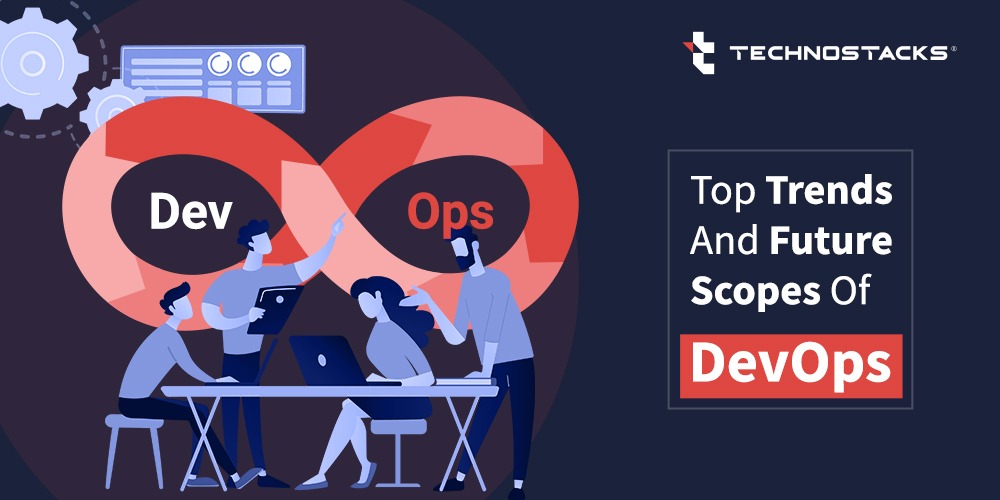DevOps Trends and Best Practices to Watch for in 2022
DevOps serves as the fusion of development and operations and has been very famous. Since 2009 it has been evolving continuously, and there has been research conducted that also shows the promising aspects of DevOps.
In this particular article, you will come to know the DevOps Trends that are continually evolving to make it one of the most popular Technologies during the pandemic in 2020 and 2021.
The rise of DevOps has been enormous. These days, most companies reserve 10 percent and 49 percent of their overall QA budget towards testing automation.
What are the Latest Trends for DevOps?
There has been digitization and automation everywhere, flourishing even more than the previous years when it has come to the technology in every unit. Explore DevOps trends for 2022 that are worth involving as a part of the business strategies.
A highlight on the different and major DevOps trends
- Microservice Architecture
According to Statista, 80 percent of respondents believe that DevOps is important. Microservice architecture is proving to be one of the cutting-edge applications in 2021. It breaks the data into chunks and the independent units or entities that are flexible and scalable. Also, we matched monoliths and microservices and identified when they could be explicitly implemented.DevOps predictions for 2022 suggest there is an Introduction to small changes in the cycle that turns out to be free from hassle. The global microservices architecture market value was $2,073 million in 2018 and is predicted to reach $8,073 million by 2026.In DevOps, there has been a requirement for the deployment of the new version, and you merely can’t go ahead with the deployment of the minor features or the functionalities.
In this regard, there has been an involvement of the microservice architecture. DevOps consulting has been on the rise. DevOps with Microservice architecture is effectively overpowering the complications that it involves by enabling supple cycles. Customization will also be favoring the rise of the scaling options.
- Application of DevSecOps
DevSecOps is one of the new trends for DevOps which refers to the involvement of DevOps and security. Though it may seem to be a new concept, it has been in use lately. With all the attacks, vulnerabilities, and security breaches causing several issues around the different networks today, DevSecOps has figured out the agile security network that will be figuring out the security issues and then incorporating the new technologies for keeping away all sorts of hazards.Besides, DevSecOps can also substantially reduce cost and speed up things. Verified Market Research reports suggest that the WorldwideDevSecOps Market value was $ 2.18 Billion in the year 2019 and will reach-out$ 17.16 Billion by 2027. That said, it has been growing at a CAGR of 30.76 percent from 2020 to 2027. Current trends and future DevOps predictions suggest that DevSecOps systems ensure the security and auditing aspects of the system. - Going Completely Serverless
Going completely serverless is one of the following logical and Top DevOps trends that DevOps has taken lately. The serverless architecture market with new frontiers of DevOps has been projecting enormously to the new standards and reducing the infrastructure cost.Effectiveness is also coming up, and there is speed and efficiency in it. The use of serverless architecture ensures that the developers can stay relieved from the maintenance issues. That said, there has been a continuous shift in the next-generation microservices.
Read More:- DevOps Tools - Hybrid as the New Deployment Normal
In 2021, industries are embracing the utilization of Hybrid on multiple facets. The updated DevOps practices mention that the businesses will be fully embracing the Hybrid workforces for combining the advantages of remote work and onsite team collaboration. In addition to that, the business models are also becoming Hybrid such as they are influencing the conferences.Hybrid networks can merge the virtual skill with the local networking. Hybrid is also becoming the deployment norm as companies modernize their stack to take advantage of cloud-native technologies. - Resilience Testing becoming the Mainstream
The DevOps community has been continually focusing on resilience testing. There has been an intersection between performance, testing, observability, performance testing, and resilience testing that are becoming the mainstream.So, when it comes to the recent DevOps Technologies, it can be said that there is a huge digital transformation that is accelerating in all the spheres. The market soon will realize that the public and the private Cloud have provided infinite scalability. - GitOps becoming the New Normal
The development processes always require the tools that the developers know and understand. So, when it comes to this technological field, then GitOps with DevOps is the best way for doing continuous delivery. More specifically, it can be said that the operating model for building cloud-native applications is utilizing the new technologies with it.Gitops also ensures the deployment, monitoring, and management all in one place. So, it works in the form of the source of the declarative infrastructure as well as applications.When it comes to automated CI/CD pipelines rolling out the infrastructure changes, it always uses different tools for comparing the actual production state. Also, it considers what is under source control and alerts you whenever there is a divergence from it.
So, it can be said that the ultimate goal of this technology is to speed up the development so that the teams are always ready to incorporate the changes and updates. In addition to that, there will be safety and security in the entire environment for making the changes. Also, it can ensure that the complex applications running in the Kubernetes do not face issues due to the vulnerabilities.
- The Incorporation of Infrastructure as Code (IaC)
Infrastructure as code has been the core tenet of DevOps in cloud locations. The storage devices, service networks, either on-premise or in the Cloud, falls under the category “Code.” It will allow the companies to automate and simplify the infrastructure.In addition to that, infrastructure as code is also going to deliver the straightforward infrastructural version control system that ensures that the teams will be rolling back to the last. So there will be the result in Rapid recovery and the reduced downtime with the infrastructure as code and DevOps. - CISOs Embracing the DevSecOps Model
CISOs embracing the DevSecOps model is a trending solution lately as it has been bringing the “security first” approach associated with the DevOps process.DevSecOps, in this regard, integrates security and compliance testing, and also there is a connection to the development pipelines. This technology aims to ensure the incorporation of swiftness in speed and agility in security mechanisms.Also, the technology prompts responses towards change, leading to quick detection of vulnerabilities and bugs. CISOs focus on security as modern organizations look forward to adopting serverless, Kubernetes, and cloud-native technologies. DevSecOps has been becoming more programmable with automation.
- Enablement of Kubernetes
Kubernetes allows the developers to easily share different software and applications that have been associated with the IT operations team. All of this happens in real-time. The reason for bugs is a difference in the IT environment as well as infrastructure.Kubernetes ensures combating hindrance, and the goal is collaboration and effectiveness between teams. There’s a massive boost to efficiency by opting for the Kubernetes workflow. In addition to that, it also provides an ease to the test/ build/ deploy pipelines in DevOps. - Incorporation of the Artificial Intelligence (AI)
The DevOps team utilizes technologies like AI and ML for the facilitation of workflow. In this special regard, it can be said that AI optimizes the DevOps environment. Also, it is focused on the handling and managing of big data.The AI-driven approach has now become a specific tool that ensures a better decision-making process. The reports from Gartner suggest that 40 percent of DevOps teams will use application and infrastructure monitoring apps with integrated artificial intelligence by 2023. AI guarantees data accessibility providing data seamlessly to the DevOps team. - Use of Automation
DevOps considers the strategy “Automate Everything.” In this particular regard, it can be better said that automation in DevOps increases software delivery speed and also, it minimizes the lead time.The third benefit you get is reaching the market faster and improving workflow. Some common benefits include driving flexibility, agility, etc. Automation accelerates the speed of everything involved in DevOps.That said, it can give a massive boost to building, deploying, or monitoring. That said, the automation strategy has turned out to be the absolute requirement in DevOps to minimize errors from human negligence or ignorance. There has been the crucial role of automation in delivering the desired results to the client.
- Infrastructure Automation (IA) and Continuous Configuration Automation (CCA) Tools
DevOps teams are looking forward to leveraging IA tools to bring automation. It favors automation in the delivery, configuration, and management of the IT infrastructure. IA tools ensure empowering the DevOps personnel.That said, it can help with the management of the multi and hybrid cloud infrastructure orchestration. In addition to that, there is also the involvement of the design delivery services on-premise.Also, there is the involvement of the cloud environments, with the involvement of effective resource provisioning. Involvement of the IA tools with the DevOps and I&O teams ensures proper planning and execution of the self-service.
Lately, most companies are taking into consideration automated delivery services with the on-premises and IaaS environments. The advantage and gain of doing so are that the DevOps personnel get the scope for providing customer-focused agility. Also, it can help with driving robust improvements.
Upsurge in Continuous Configuration Automation (CCA) tools is because it helps with the management and delivery of the configuration changes as code. What makes it even better is increasing the scope for expanding into networking, containers, and security.
Some of the new metrics adopted lately include Application Release Automation (ARA), IT Operations Analytics (ITOA), and Continuous Configuration Automation (CCA). All these entities are beneficial because they help ITOps teams to propel business success.
- Facilitating Chaos Engineering
Chaos Engineering involved in DevOps has become one of the prime considerations in the DevOps planning discussions. For a better understanding, there is a need to take the DevOps within a traditional level of the maturity model.In this specific regard, it can be said that Chaos Engineering is proving to be the high-end 4th or 5th level discipline included in the list of DevOps practices. There has been an involvement of the separate Testing / Quality Assurance group.
Key Takeaways
We have listed the DevOps trends to follow in 2022. The final verdict is that DevOps has been proving to be the newer trend and the future of the entire IT industry. One can get a range of benefits with the incorporation of effective and efficient DevOps solutions.
Here, it is worth noting that the business needs experienced DevOps professionals to support the next-gen DevOps services. The aim is to better bridge the gap amid development and operations. In addition to that, these technologically refined solutions can guarantee driving your business growth.








